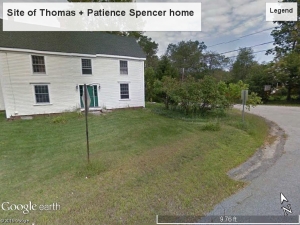James Goodwin was lucky to be alive. He was fortunate to be born around 1711 in Berwick, Massachusetts Colony (now Maine), among the younger of Thomas Goodwin and Mehitable Plaisted’s children. He was blessed to find a wife in Margaret Wallingford, who was born circa 1716 in Dover, New Hampshire, to Thomas Wallingford and Margaret Clements. James and Margaret both lived good, long lives: James dying on May 10, 1800 and Margaret on February 20, 1803. Both lived to see the birth of their new country for which their son Jedidiah helped fight. What made James so lucky? It all began with the story of his parents, particularly his mother, Mehitable Plaisted.
Mehitable was born April 30, 1670 (old calendar) to Roger Plaisted and Olive Coleman. She was among the last of their many children. Roger and Olive, along with their firstborn, Roger, travelled from England around 1649, and settled in the Kittery area of the region of Maine (which eventually became Berwick). They soon became part of the growing colonial community. Where relations between the colonists and the local Waramaug natives started off on a friendly foot, things quickly deteriorated with misunderstandings and violence on both sides. Soon, what was known as “King Philip’s War” was underway, starting about June 1675 on many fronts throughout New England.
Mehitable was only five years old when her father and older brothers, Roger and Joseph, joined other area colonists in the military defense of their towns. Her father, Roger, was a lieutenant of the defense in the Kittery area. Early in the war, on October 16, 1675, Lieut. Plaisted and George Broughton sent a desperate plea to the surrounding communities for assistance as they saw their men being killed off by the natives. The Plaisted men became part of the casualties that very day.

from “King Philip’s War” by George William Ellis & John Emery Morris; Grafton Press, New York; 1906; Google Books, 2007.
King Philip’s War lasted about three years until a peace treaty was signed. However the colonists were far from living peacefully with the natives. I’m sure the early communities in Maine were constantly vigilant against future troubles. In spite of that, life did go on. Olive Plaisted re-married to John Wincoll, who served as a stepfather to Roger’s children. Mehitable herself got married around 1685 to Thomas Goodwin, son of Daniel Goodwin and Margaret Spencer. They started their family with a baby boy.
When the baby was about five months old in the early winter months of 1690, the natives descended on the town; not to kill this time, but to capture. The entire family was taken, but Thomas was with a separate band of natives than his wife and child. Somehow, he was either released or managed to escape shortly thereafter. Mehitable and the baby were not as lucky. Their story is told dramatically in Cotton Mather’s Magnolia Christi Americana:
[The baby] which, through hunger and hardship, (she being unable to nourish it,) often made most grievous [cries]. Her Indian master told her, that if the child were not quiet he would soon dispose of it; which caused her to use all possible means that his Netop-ship might not be offended; and sometimes carry it from the fire out of his hearing, where she sat up to the waste [sic.] in snow and frost for several hours until it was lull’d asleep. She thus for several days preserved the life of her babe, until he saw cause to travel with his own cubs farther afield; and then, lest he should be retarded in his travel, he violently snatch’d the babe out of its mother’s arms, and before her face knock’d out its brains, and stript it of the few rags it had hitherto enjoy’d, and order’d her the task to go wash the bloody cloaths. Returning from this melancholy task, she found the infant hanging by the neck in a forked bough of a tree. Sho desired leave to lay it in the earth; but he said, “it was better as it was, for now the wild beasts would not come at it, … and she might have the comfort of seeing it again if ever they came that way. The journey now before then) was like to be very long, even as far as Canada, where his purpose was to make merchandise of his captive, and glad was the captive of such happy tidings. But the desperate length of the way, and want of food, and grief of mind wherewith she now encounter’d, caused her within a few days to faint under her difficulties. When at length she sat down for some repose, with many prayers and tears unto God for the salvation of her soul, she found herself unable to rise, until she espied her furious executioner coming towards her with fire in his eyes, the devil in his heart, and his hatchet in his hand, ready to bestow a mercy-stroak of death upon her. But then this miserable creature got on her knees, and with weeping, and wailing, and all expressions of agony and entreaty, prevailed on him to spare her life a little, and she did not question but God would enable her to “walk a little faster.” The merciless tyrant was prevail’d withal to spare her this time…
Mehitable and the other captives changed hands among several bands of natives along the journey and were ultimately sold to the French Canadians by about March 1690. (The histories I’ve read don’t say this, but yes, basically selling them as slaves.) Mehitable was put into service to a Mademoiselle de Nauguiere in Montreal. I suppose that escape wasn’t really an option; after all, she would need to go back through the native-filled country that she traversed to get to Montreal.
It seems that Mehitable must have made the best of her circumstances. On May 11, 1693, she was baptized into the Catholic Church with the name “Marie Esther”. More time passed, and it wasn’t until October 1695 when a Matthew Cary came to redeem Mehitable and a number of other captives in order to return them to their families. (I would love to know more about this man and the story behind his redeeming the captives!)
What I find incredible and wish I knew more about is Mehitable’s eventual return to her family. Where many captives assimilated to their new culture and some even refused to leave, Mehitable returned to the waiting Thomas and seemed to continue where they left off. The Goodwins re-built their family (which included my ancestor James), and had about nineteen more years together until Thomas’ death sometime after June 3, 1714.
Mehitable lived on much longer, passing away on June 2, 1740. In fact, her gravestone still stands in Old Fields Cemetery in South Berwick. She must have had amazing strength and resilience to have endured all that she did and to still have a normal and long life later on.























